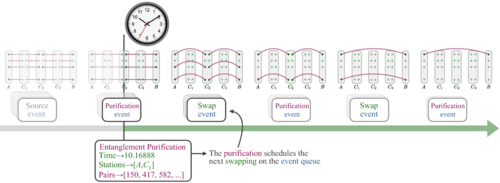Quantum repeaters are a key component in quantum communication, designed to combat losses and errors that occur over long distances. They operate differently from classical repeaters and are essential for real-world implementations of key distribution. Despite the known principles of quantum repeaters, their full-scale realization remains a major technological challenge due to the complex interplay of components. A simulation platform, ReQuSim, has been developed to assess the performance of quantum repeaters, providing valuable insights into their implementation and strategies for improvement. The future of quantum repeaters lies in overcoming these technological challenges, with simulation platforms playing a crucial role.
What are Quantum Repeaters and Why are They Important?
Quantum repeaters are a crucial component in the field of quantum communication, particularly for distributing entanglement over long distances. They are essential for real-world implementations of key distribution over arbitrary distances, especially for locations on earth. Quantum repeaters are designed to combat unavoidable losses and errors that occur in quantum communication. Unlike classical strategies of signal amplification used in classical repeaters, quantum repeaters operate on a different principle.
The concept of quantum repeaters was devised to overcome the limitations of direct quantum communication. While direct quantum communication has seen impressive implementations, it has its limits. Quantum repeaters help overcome these fundamental limits, known as the repeaterless bound or the PLOB bound. The ultimate limits in the presence of repeaters are substantially more favorable.
Since the first repeater proposals, substantial research effort has been dedicated to experimentally realizing full-scale quantum repeaters. These realizations remain a major technological challenge and therefore one of the main goals of the quantum communications field is to overcome this significant bottleneck. The technological challenges are not so much conceptual—the basic principles have been known for a long time—but arise from the complicated interplay of the components which include quantum light and usually matter qubits.
What are the Challenges in Implementing Quantum Repeaters?
There are numerous open questions about implementation details for realistic near-term experimental setups of quantum repeaters. From a high-level perspective, there are indeed a number of open challenges when considering more advanced repeater schemes. For one, there are many design features for variants of repeater protocols that can be modified or combined. Also, it is very difficult to compare advantages between vastly different platforms involving trapped ions, nitrogenvacancy (NV) centers, silicon-based systems, or atomic gases.
For simple paradigmatic problems, some settings can be analytically studied even involving some experimentally relevant parameters. Beyond such paradigmatic settings, an analytical study seems to be out of reach. Several large-scale initiatives that are aiming at realizing quantum networks within the quantum Internet—such as the Quantum Internet Alliance or the Quantum Internet Task Force—have set up simulation schemes for simulating high-level quantum communication protocols.
How Can Simulation Help in Implementing Quantum Repeaters?
In order to assess the performance of realistic repeater protocols, a comprehensive Monte Carlo-based simulation platform for quantum repeaters called ReQuSim has been presented. This platform faithfully includes loss and models a wide range of imperfections such as memories with time-dependent noise. It allows for an analysis for quantum repeater setups and strategies that go far beyond known analytical results.
ReQuSim is an event-based Monte Carlo simulation platform for realistic quantum repeaters which is versatile enough to study complex repeater schemes for realistic small-to-intermediate-scale quantum networks. It is faithful to a wide range of physically relevant parameters on the hardware level of quantum repeaters. This platform allows us to compare different physical architectures fairly, to explore new regimes, and to identify new, possibly unexpected schemes in the first place.
With respect to realism, the platform is detailed enough to include arbitrary time-dependent decoherence mechanisms. This is a significant advancement in the field of quantum communication as it allows for a more accurate and realistic simulation of quantum repeater protocols.
What are the Findings from the Simulation?
The simulation platform ReQuSim has presented a number of findings centered around the combination of strategies for improving performance such as entanglement purification and the use of multiple repeater stations. It demonstrates that there exist complex relationships between them.
The findings stress that numerical tools such as ReQuSim are essential to model complex quantum communication protocols aimed at contributing to the quantum Internet. The platform allows for a more detailed and accurate analysis of quantum repeater setups and strategies, capturing more realistic noise models and analyzing more complex repeater strategies.
These findings are significant as they provide valuable insights into the implementation of quantum repeaters and the strategies that can be employed to improve their performance. They also highlight the importance of simulation tools in advancing the field of quantum communication.
What is the Future of Quantum Repeaters?
The future of quantum repeaters lies in overcoming the technological challenges associated with their implementation. The basic principles of quantum repeaters have been known for a long time, but the challenges arise from the complicated interplay of the components which include quantum light and usually matter qubits.
The use of simulation platforms like ReQuSim will play a crucial role in this process. By allowing for a more detailed and accurate analysis of quantum repeater setups and strategies, these platforms can help identify new, possibly unexpected schemes and explore new regimes.
The findings from these simulations will contribute to the development of the quantum Internet, a large-scale initiative aimed at realizing quantum networks. As the field of quantum communication continues to advance, the role of quantum repeaters and the strategies for their implementation will continue to evolve.
Publication details: “Faithfully Simulating Near-Term Quantum Repeaters”
Publication Date: 2024-03-27
Authors: Julius Wallnöfer, Frederik Hahn, Fabian Wiesner, Nathan Walk, et al.
Source: PRX Quantum 5, 010351
DOI: https://doi.org/10.1103/PRXQuantum.5.010351

